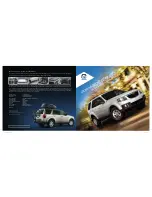
Tyre traction
G
WARNING
Whereas the vehicle can be fully controlled at
a certain speed on dry roads, you must reduce
your speed on wet or icy roads to achieve the
same road safety. You could otherwise cause
an accident.
Pay particular attention to the road conditions
at temperatures around freezing point.
If ice has formed on the road surface (e.g.
from fog), a thin film of water rapidly forms on
the ice when you brake, considerably reduc-
ing tyre traction. Drive with particular care in
such weather conditions.
Driving on wet roads
Aquaplaning
If water has accumulated to a certain depth
on the road surface, there is a danger of aqua-
planing occurring, even if:
R
you are driving at low speeds.
R
the tyres have adequate tread depth.
For this reason, do not drive in tyre ruts, and
brake carefully.
Driving on flooded roads
If you have to drive on stretches of road on
which water has collected, please bear in
mind that:
R
the maximum permissible still water depth
is 25 cm.
R
you should drive no faster than at walking
pace.
!
Bear in mind that vehicles travelling in
front or in the opposite direction create
waves. This may cause the maximum per-
missible water depth to be exceeded.
These notes must be observed under all
circumstances. You could otherwise dam-
age the engine, the electronics or the trans-
mission.
Winter driving
Important safety notes
G
WARNING
If the vehicle becomes trapped in snow,
ensure that snow is kept away from the
exhaust pipe and from around the vehicle as
long as the engine is running. Otherwise, poi-
sonous carbon monoxide (CO) may enter the
vehicle, resulting in loss of consciousness and
even death.
To assure sufficient fresh air ventilation, open
a window slightly on the side of the vehicle
not facing the wind.
Have your vehicle winterproofed at a qualified
specialist workshop at the onset of winter.
Driving with summer tyres
Observe the notes in the "Winter operation"
section (
Y
page 364).
Slippery road surfaces
G
WARNING
Do not shift down for additional engine brak-
ing on a slippery road surface. This could
cause the drive wheels to lose their grip and
the vehicle could skid.
You should drive particularly carefully on slip-
pery road surfaces. Avoid sudden accelera-
tion, steering and braking manoeuvres.
If the vehicle threatens to skid or cannot be
stopped when moving at low speed:
X
Vehicles with manual transmission:
shift to neutral.
X
Vehicles with automatic transmission:
shift the transmission to position N.
X
Try to bring the vehicle under control by
using corrective steering.
i
For more information on driving with
snow chains, see (
Y
page 365).
180
Driving tips
Driving
and
parking
Содержание E-Class 2011
Страница 2: ......
Страница 3: ......
Страница 5: ......
Страница 43: ...40 ...
Страница 83: ...80 ...
Страница 105: ...102 ...
Страница 155: ...152 ...
Страница 231: ...228 ...
Страница 291: ...288 ...
Страница 292: ...Useful information 290 Loading guidelines 290 Stowage areas 290 Features 307 289 Stowing and features ...
Страница 322: ...Useful information 320 Engine compartment 320 Maintenance 325 Care 326 319 Maintenance and care ...
Страница 337: ...334 ...
Страница 381: ...378 ...
Страница 405: ...402 ...
Страница 406: ...403 ...
Страница 407: ...404 ...
Страница 408: ......
Страница 409: ......















































